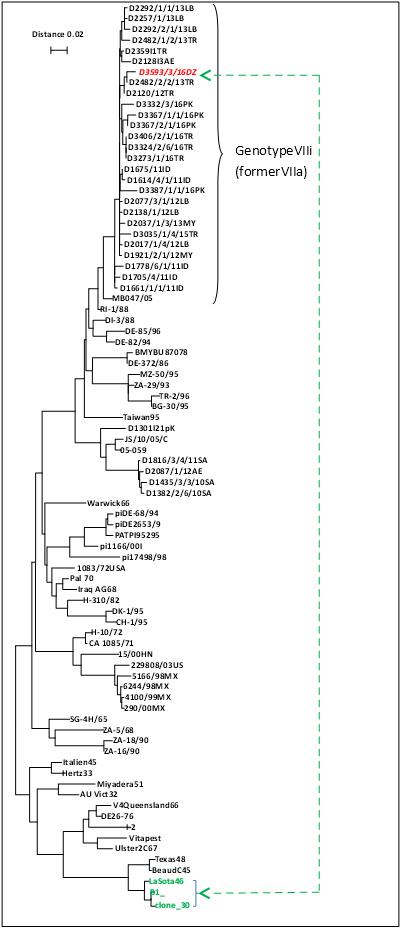First phylogenetic analysis of new Newcastle virus strain isolates in Algeria
Published: December 22, 2017
By: Mohamed-Amine Bouderbal 1, Moncef Bouzouaia 2.
/ 1 Ceva Animal Health, Algiers, Algeria; 2 National Veterinary School of Sidithabet, Tunis, Tunisia.
Introduction:
Newcastle disease in chicken is caused by an avian paramyovirus serotype 1 (APMV1), it is one of the most economically and prevalent pathology around the world.
It was first identified in Java (INDONESIA) in 1926 and 1927 in Newcastle-upon-Tyne, England. However, it may have been prevalent as early as 1898, when a disease wiped out all the domestic fowl in North West Scotland (Macpherson et al., 1956).
Currently, the circulating strains associated with disease outbreaks worldwide predominantly are from genotypes V, VI, and VII of class II (Aldous et al., 2003; Lin et al., 2003).
Genotype VII was initially divided into two subgenotypes: VIIa, representing viruses that emerged in the 1990 s in the Far East and spread to Europe and Asia and VIIb, representing viruses that emerged in the Far East and spread to South Africa (Aldous et al., 2003). The two sub-genotypes of VII are further divided into VIIc, d, and e, which represent isolates from China, Kazakhstan and South Africa (Bogoyavlenskiy et al., 2009; Wang et al., 2006), and VIIf, g, and h, which represent African isolates (Snoeck et al., 2009). In Egypt, The sub-genotype VIId is predominant causing several ND outbreaks in poultry (Radwan et al., 2013).
Algeria has declared 3 times the Newcastle disease to the OIE between 1990 and 2012 (1992, 1997 and 2012). The disease causes inflammation of the respiratory tract and breathing difficulty, resulting between 5 to 15% mortality. The disease was successfully controlled by vaccination with conventional vaccine used in the field administered by drinking water or nebulization.
The situation changed in 2012 when a new virus strain was isolated from vaccinated flocks both in the East and West regions of Algeria. This virus was causing nervous symptoms: petechia in the proventriculus as well as a high level of mortality up to 67 % in vaccinated flocks, and up to 45 % of drop in laying hens.
The aim of this study was the examination of the genetic diversity of Newcastle virus strain isolated in Algeria starting from 2013 to 2016 that causes a high level of mortality in flocks that use conventional vaccines.
MATERIALS AND METHODS
Viruses pools of 2 chicken imprints on FTA cards were submitted from each 40 chicken flocks for ND investigation from Algeria during the period of 2014 to 2016.
The flocks were selected after calls from the veterinarian in charge to signal a high level of mortality or an egg drop with nervous symptoms or petechia in the proventriculous after necropsy.
After the prints were made, the FTA card was sent to PHYLAXIA Laboratory in Hungary in order to check by PCR the positivity of the samples and after a sequencing in order to identify the genotype of the virus if the results were positive.
RNA purification and RT PCR:
Viral RNA purification from FTA card was performed by RNA rapid extraction solution (Life Technologies) and MagMax Viral RNA isolation kit (Life Technologies) according to the manufacturer instruction. Purified RNA was used as template for the reverse transcription using MMLV-reverse transcriptase (Promega) and random hexamer primers (Promega) according to the manufacturer’s description.
NDV PCR was performed using K1-K2 primer pair, which amplifies a 1008bp long region between M gene position 778 and F gene position 545. (Lomniczi et. al. 1998 Arh.Virol 143:49-64).
Sequencing and phylogenetic analysis:
Sequence differences of the PCR products in comparison with reference strains (obtained from GenBank) were calculated by Kimura’s method and phylogenetic tree was constructed using the Neighbor-joining method by TREECON for Windows program.
RESULTS:
Figure 1: Phylogenic analysis of Algerian Newcastle virus isolates using Sequence differences of the PCR products in comparison with reference strains (obtained from GenBank) were calculated by Kimura’s method and phylogenetic tree was constructed using the Neighbor-joining method by TREECON for Windows program, it shows also the genetic distance between the field isolates and the strain used in the vaccination program in Algeria. Based on the 374 base pairs long (47-420 bp) nucleotide sequence of the F gene of NDV.

Table 1: Summary results of Newcastle genotype identification (2014 to 2016)
Five from 8 field sample originated from 4 layer farms between 4 and 14 weeks and 3 broiler farms were positive for NDV by RT-PCR between 2014 and 2016. All the positive grouped together with Velogenic NDV genotype VII strain, this group of isolates showed the closest relation to the Turkish, Pakistani and Arab Emirates ND virus.
There is a large genetic distance between the genotype found in the field and the genotype of the vaccine strain usually used in prophylactic program in Algeria (La Sota and Clone 30).
All positive cases underwent a minimum of 32% mortality preceded by acute nervous symptoms and all of them were vaccinated at least twice with live vaccines (La sota or Clone 30) or live and inactivated vaccines.
Pictures 1,2,3 and 4: Acute nervous symptoms on broiler chicken (East region of Algeria)

CONCLUSIONS:
The velogenic Newcastle genotype VII is present in Algeria causing considerable economical loses.
NDV genotype VII began to replace genotype V as the most prevalent genotype in domestic flocks in Algeria.
There is a large genetic distance between the genotype discovered in the field and the genotype of the vaccine strain usually used in prophylactic program (La Sota and Clone 30).
Simultaneous detection of velogenic strains of NDV from various regions of the country warrants continuous isolation and molecular epidemiological investigations involving layers and broilers. Vaccine strategies that can elicit high antibody response along with continuous monitoring from the laboratory coupled with improved biosecurity measures in the farm is suggested.
Presented at the XX World Veterinary Poultry Association Congress Edinburgh 2017.
REFERENCES
Macpherson, LW (May 1956). "Some Observations On The EpizootNewcastle NewCastle Disease". Canadian journal of comparative medicine and veterinary science. 20 (5): 155–68. PMC 1614269?. PMID 17648892.
E.W. Aldous, J.K. Mynn, J. Banks, D.J. Alexander. A molecular epidemiological study of avian paramyxovirus type 1 (Newcastle disease virus) isolates by phylogenetic analysis of a partial nucleotide sequence of the fusion protein gene. Avian Pathol.: J. W.V.P.A, 32 (2003), pp. 239-256.
A. Bogoyavlenskiy, V. Berezin, A. Prilipov, E. Usachev, O.Lyapina, I. Korotetskiy, I. Zaitceva, S. Asanova, A.Kydyrmanov, K. Daulbaeva, L. Shakhvorostova, M.Sayatov, D. King. Newcastle disease outbreaks in Kazakhstan and Kyrgyzstan during 1998(2000), 2001, 2003. 2004, and 2005 were caused by viruses of the genotypes VIIb and VIId. Virus Genes, 39 (2009), pp. 94-.
C.J. Snoeck, M.F. Ducatez, A.A. Owoade, O.O. Faleke, B.R. Alkali, M.C. Tahita, Z. Tarnagda, J.B. Ouedraogo, I.Maikano, P.O. Mbah, J.R. Kremer, C.P. Muller. Newcastle disease virus in West Africa: new virulent strains identified in non-commercial farms. Arch. Virol., 154 (2009), pp. 47-.
M.M. Radwan, S.F. Darwish, I.M. El-Sabagh, A.A. El-Sanousi, M.A. Shalaby. Isolation and molecular characterization of Newcastle disease virus genotypes II and VIId in Egypt between 2011 and 2012. Virus Genes, 47 (2013), pp. 311.
Related topics:
Authors:
Ceva Animal Health
Recommend
Comment
Share
28 de diciembre de 2017
Well done.
I personnelly agree with you about Circulation of APMV Genotype VII in algerian poultry flocks and its huge economic losses.
Dear dr you said in your paper that genotype VII replaces genotype V!!!! May i ask you about the refrence that speaks about existance of genotype V in algerian flocks?
Salutations
Recommend
Reply
Recommend
Reply
3 de enero de 2018
Congratulations for this publication.
Do you have any other isolates done in Algeria?
I ask you this question to see the evolution of Algerian strains in a phylogenetic tree.
In advance, thank you for your answer.
Dr. ABED
Recommend
Reply
27 de diciembre de 2017
Good work. We have isolated and characterized APMV-1 genotype VII from poultry in Libya during multiple outbreaks on 2013. A paper was published in Avian Diseases:
Abdulwahab Kammon, Alireza Heidari, Abdunaser Dayhum, Ibrahim Eldaghayes, Monier Sharif, Isabella Monne, Giovanni Cattoli, Abdulatif Asheg , Milad Farhat, and Elforjani Kraim (2015) Characterization of Avian Influenza and Newcastle disease viruses from Poultry in Libya. AVIAN DISEASES 59:422–430.
Genotype VII is now circulation in north Africa.
Recommend
Reply

Would you like to discuss another topic? Create a new post to engage with experts in the community.













.jpg&w=3840&q=75)